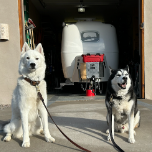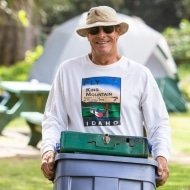
dhaig
Members-
Posts
132 -
Joined
-
Last visited
-
Days Won
1
dhaig last won the day on September 22 2022
dhaig had the most liked content!
My Info
-
Gender or Couple
Couple
-
Location
Dallas, TX
- Website
My RV or Travel Trailer
-
Do you own an Oliver Travel Trailer, other travel trailer or none?
I own an Oliver Travel Trailer
-
Hull #
990
-
Year
2022
-
Make
Oliver
-
Model
Legacy Elite II
-
Floor Plan
Twin Bed Floor Plan
Recent Profile Visitors
dhaig's Achievements
-
Starlink Mini Installation- 2022 LEII- Alternate Approach
dhaig replied to dhaig's topic in Ollie Modifications
@Steve and Cindy, the RJ45 connector is reasonably well protected from rainfall when in use. The original Furrion cover acts as a small roof over the pass-through connector and cable when in use. When not in use, the black plastic cap for the pass-through connector fits into the RJ45 port and the Furrion cover closes over it. We have used the Starlink PoE setup through one thunderstorm will no ill effects observed. I examined the connector following the thunderstorm and did not see the need to add any further protection. Regards, Don -
@Snackchaser/Geoff, Your comment about a third party source for freezer door hinges is very timely. The stops on the freezer hinges of our Norcold refrigerator failed on a trip last weekend. Much appreciated. Regards, Don
-
Starlink Mini Installation- 2022 LEII- Alternate Approach
dhaig replied to dhaig's topic in Ollie Modifications
@johnwen, you are correct. A blue wire connects to the DC fuse box (12VDC positive) , then to the Wago connector. From the Wago another blue wire runs to the POE Injector. Also connecting to the Wago connector is a red wire which provides 12VDC positive to the auxiliary power outlet, providing power to the Starlink Router Mini. Apologies for the delayed response, we were traveling. Regards, Don -
Use space heater when below freezing???
dhaig replied to Dennis and Melissa's topic in General Discussion
@Dennis and Melissa, we have carried a small 120V ceramic heater when traveling during months when below freezing is possible. I included this heater on our trailer delivery trip in February, 2022, based on recommendations I had read on this forum. When enroute back to Dallas we encountered freezing weather and stopped for the night at a convenient RV park along I40, about an hour east of Little Rock. The temperature was below freezing when we pulled in, about 10PM. I had to chip ice off the water spigot to take on some fresh water. We had the furnace running and the temperature inside the trailer was comfortable when we went to bed. Several hours later, I awoke cold and the furnace was not operating. Assuming we had exhausted the propane in one tank, I dressed and went outside to switch the regulator to draw propane from the other tank, which we knew to be full. The outside temperature was in the low to mid 20s. Long story short, we were unable to get the furnace to startup by drawing propane from the full tank. I messed with the regulator, but could not get propane to flow. I tried connecting the hose from the first (now empty) tank to the full tank, but still no flow through the regulator. Consequently, I pulled out the ceramic heater and got It running on shore power. The ceramic heater could maintain the temperature in the trailer at about 60 degrees. I had no way to measure the temperature between the hulls, but I knew very little of the heat from the ceramic heater would benefit that space. We decided to forego morning showers and prepared to get underway back to Dallas, where the temperature was likely to be above freezing. Before departing, at 8AM Eastern time, I phoned Oliver Support and described our problem. They suggested measures we had previously tried, and suggested trying to light the cooktop to determine if propane was flowing. The cooktop would also not light. Oliver Support suspected the regulator was faulty and committed to shipping out a new regulator the same day. About two days later the new regulator was delivered to our home. I installed the new regulator and the problem was solved. All gas appliances now operated normally. The lesson I took from this experience was to carry the ceramic heater as a backup to the propane furnace if traveling during months when freezing weather is likely. So long as the propane furnace is operable and there is an adequate supply of propane I would rely on the propane furnace as the better protection from freezing water lines within the trailer. I would turn to the electric heater ONLY as a backup to the propane furnace. Especially at night I feel the safer option is to run the furnace, not knowing how low the outside temperature may drop to during the night. We have had no further occasions when the furnace would not operate and have stayed in the trailer multiple nights in similar temperatures. -
Do you drink the water from your fresh tank?
dhaig replied to Dennis and Melissa's topic in General Discussion
@Steve Morris, could you please provide details on the water filtration system shown in the photo you posted. Also please include details on how you mount the filter system to the side of the waste hose storage compartment. Thanks, Don -
Starlink Mini Installation- 2022 LEII- Alternate Approach
dhaig replied to dhaig's topic in Ollie Modifications
@johnwen, yes, I neglected to mention the wire I had listed as going to the Mini Router goes to the 12VDC auxiliary power outlet for the Router Mini. A USB-C adapter plugs into the auxiliary power outlet, then USB-C cable to the Mini Router. Sorry for the confusion. The power switch mount on the basement wall controls power to both the PoE Injector and the Router Mini's power supply (USB-C). -
Starlink Mini Installation- 2022 LEII- Alternate Approach
dhaig replied to dhaig's topic in Ollie Modifications
@johnwen, your guess was correct. The switch mounted on the forward basement wall connects to what had been a spare circuit on the fuse block via a junction. Three wires are connected by a Wago lever connector: wire from switch wire to the Mini Router wire to the fuse block If you used the same lighted rocker switch as I did, it has three wires, one smaller than the other two. This small wire needs power for the LED light in the switch. Don -
Starlink Mini Installation- 2022 LEII- Alternate Approach
dhaig replied to dhaig's topic in Ollie Modifications
@johnwen, my apologies for the delayed response to your question about mounting the PoE Injector on the forward wall of the basement, where I located the On/Off Switch. I had not seen your question. I don't see any problem locating the PoE Injector on the wall, as you suggested. I would not mount it on the basement side of the wall, but on the back side of that wall. Drilling holes for the mounting may be challenging from inside the space under the rear street side access hatch. I chose to locate my PoE Injector and Router Mini under the aft dinette seat, since that space is more easily accessible having to move only the seat cushions and not the street side mattress. -
dhaig started following Steve Morris
-
@jd1923, I agree with your preventative maintenance philosophy and with having the right tools to deal with necessary repairs. I would rather spend the time and, if necessary, the money to address maintenance/repairs at home, or in nearby shops, rather than some remote location while traveling. Your description of checking the brakes and tightening the self-adjusters caused me a flashback to teenage years and a hands-on lesson in replacing brakes shoes and rebuilding wheel cylinders, under my Dad's direction. I still have the brake adjustment lever tool acquired then. Due to the limited storage space and desire to avoid adding unnecessary weight, I am inclined to adopt your approach, to carry only the critical bearing press fittings you have identified and a couple of sets of replacement bearings and associated parts. On the road, I would be most likely to seek out the nearest shop to perform the repair. Failure of wheel bearings is among the few potentially disabling items on the trailer. Failure of other items, such as water pumps may be inconvenient, but not likely to prevent returning home. I will add to my maintenance list an annual check of the bearings and brakes by lifting the wheels of the ground. Thanks for your detailed responses to my questions. Regards, Don
-
Starlink Mini Installation- 2022 LEII- Alternate Approach
dhaig replied to dhaig's topic in Ollie Modifications
@Steve Morris I purchased the same tripod adapter. It works quite well. We have an old aluminum tripod which I plan to use as the primary support for our Mini. -
Starlink Mini Installation- 2022 LEII- Alternate Approach
dhaig replied to dhaig's topic in Ollie Modifications
@Steve Morris I am pleased you found the tips helpful. It looks like you are on your way with the install. I like your base for the Starlink Mini. It certainly keeps it off the ground. 😀 -
Starlink Mini Installation- 2022 LEII- Alternate Approach
dhaig replied to dhaig's topic in Ollie Modifications
@johnwen, my apologies, I thought I had included the details on the Ethernet cable running from the RJ45 through jack utilizing the Furrion external shell. All of the Ethernet cables I purchased are Cable Matters products. All are shielded Cat 6A. In addition to the 20 ft. cable used inside the trailer, I purchased a 50 ft, and 2x 25 ft. cables and a single 1ft cable. I also purchased VCE CAT6A Waterproof RJ45 Coupler IP68, 10Gbps CAT6A/CAT6/CAT5E/CAT5 Female-to-Female Outdoor Ethernet Connector Shielded, Network Cable Extender for Outdoor Use 2-Pack, 5.3 in. To connect the Ethernet cable to the PoE splitter, I had to slightly trim the black plastic anti-snag protector on the 1 foot long Cat 6A able. This was necessary because of the tight fit through the watertight connector on the PoE splitter. You may have run across mentions of this issue by others online who are using this PoE Injector and Splitter. Once I trimmed the soft plastic cover over the cable release tab I was able to fit the RJ45 connector through the watertight connector on the Splitter. I chose to use the 1 foot long cable so that I could leave the splitter and the 1 foot cable connected to Starlink Mini. I find the connectors going to the Mini from the Splitter to be difficult to remove due to the watertight seals. I don't like the idea of pulling on the cables to release the Splitter from the Mini. I anticipate repeated removal of the Splitter from the Mini will result in damage to the cables on the Splitter. Replacement Splitters appear to cost about $65. At the other end of the 1 foot cable I attached one half of the VCE RJ45 couplers listed above. This way it is much easier to disconnect the Ethernet cable from the Mini without messing with the watertight connector on the Splitter again. I also installed the VCE couplers on the ends of the 50 foot and 2x 25 foot cables. This way they are like extension cords which are easily connected/dis-connected. I am impressed with the VCE couplers. They are excellent and easy to use. I bought the three longer length cables to be able to easily connect 25, 50, 75 and 100 foot long cables, as needed. I specifically want to avoid having to deal with a single 100 foot cable, which I find to be a PITA. I have not yet had a chance to use the Starlink Mini on a trip, but have only tested it with our LEII parked in our driveway. Due to tree coverage, I needed to connect at least 75 feet of Ethernet cable to position the Mini for a reasonably unobstructed view of the sky. The Mini still had some obstructions, but I was able to measure Ethernet speeds inside the trailer >100 Mbps. I sometimes saw speeds drop to the 50-75 Mbps and rise as high as 200+ Mbps. I suspect the variable is at least partially attributable to the position of Starlink satellites at the time of the speed tests. The satellites are each only in view 8-9 minutes, without obstructions. In any case, I connected my laptop to Starlink WiFi inside the trailer and was able to browse comfortably. I did not notice the occasional losses of service which I noticed in the performance data on the Starlink app. I don't recall any RV park or state park where the provided WiFi was anywhere close to the minimum speeds I have observed in our driveway. BTW, in our residence we have AT&T wired gigabit Ethernet throughout, so I have a low tolerance for poor WiFi service. I have high expectations for using the Starlink service, based on reports by others and my experience so far. At this point, I have not used any adhesive to attach the PoE Injector to the top of the frame member on which it sits. I have a small zip tie connecting it to a PEX cold water line. With the Ethernet cables attached it cannot really go anywhere. I did not want to use a more permanent method to secure the PoE Injector, until field testing on a road trip. We have our next trip scheduled in late August, so I will observe it over a 400+ mile trip. I will likely use a small strip of 3M VHB tape to fasten to the hard rubber frame covering. Good luck with your installation. If you have any questions, feel free to send me a Personal Message and I will be happy to answer. -
Haloview BT7 Touch Rear Camera installation on 2022 LEII
dhaig replied to dhaig's topic in Ollie Modifications
@mossemi, thanks for the info on the stubby antennas. I will keep them in mind as I start using our BT7. Since the performance with the antennas laid horizontal over the top of the monitor, I will see how this works out. Do you see comparable signal strength from the study antennas as you did from the original antennas? I also take the monitor out of our TV when we setup camp. I have a translucent Sterilite storage container where I store the monitor, wireless brake controller, etc. I keep the storage container on a shelf in the closet when camped or the trailer is in storage. I wrap the monitor in a scrap piece from non-slip rug pads to protect it in storage. -
Starlink Mini Installation- 2022 LEII- Alternate Approach
dhaig replied to dhaig's topic in Ollie Modifications
@johnwen, my apologies, I thought I had included the details on the Ethernet cable running from the RJ45 through jack utilizing the Furrion external shell. All of the Ethernet cables I purchased are Cable Matters products. All are shielded Cat 6A. In addition to the 20 ft. cable used inside the trailer, I purchased a 50 ft, and 2x 25 ft. cables and a single 1ft cable. I also purchased VCE CAT6A Waterproof RJ45 Coupler IP68, 10Gbps CAT6A/CAT6/CAT5E/CAT5 Female-to-Female Outdoor Ethernet Connector Shielded, Network Cable Extender for Outdoor Use 2-Pack, 5.3 in. To connect the Ethernet cable to the PoE splitter, I had to slightly trim the black plastic anti-snag protector on the 1 foot long Cat 6A able. This was necessary because of the tight fit through the watertight connector on the PoE splitter. You may have run across mentions of this issue by others online who are using this PoE Injector and Splitter. Once I trimmed the soft plastic cover over the cable release tab I was able to fit the RJ45 connector through the watertight connector on the Splitter. I chose to use the 1 foot long cable so that I could leave the splitter and the 1 foot cable connected to Starlink Mini. I find the connectors going to the Mini from the Splitter to be difficult to remove due to the watertight seals. I don't like the idea of pulling on the cables to release the Splitter from the Mini. I anticipate repeated removal of the Splitter from the Mini will result in damage to the cables on the Splitter. Replacement Splitters appear to cost about $65. At the other end of the 1 foot cable I attached one half of the VCE RJ45 couplers listed above. This way it is much easier to disconnect the Ethernet cable from the Mini without messing with the watertight connector on the Splitter again. I also installed the VCE couplers on the ends of the 50 foot and 2x 25 foot cables. This way they are like extension cords which are easily connected/dis-connected. I am impressed with the VCE couplers. They are excellent and easy to use. I bought the three longer length cables to be able to easily connect 25, 50, 75 and 100 foot long cables, as needed. I specifically want to avoid having to deal with a single 100 foot cable, which I find to be a PITA. I have not yet had a chance to use the Starlink Mini on a trip, but have only tested it with our LEII parked in our driveway. Due to tree coverage, I needed to connect at least 75 feet of Ethernet cable to position the Mini for a reasonably unobstructed view of the sky. The Mini still had some obstructions, but I was able to measure Ethernet speeds inside the trailer >100 Mbps. I sometimes saw speeds drop to the 50-75 Mbps and rise as high as 200+ Mbps. I suspect the variable is at least partially attributable to the position of Starlink satellites at the time of the speed tests. The satellites are each only in view 8-9 minutes, without obstructions. In any case, I connected my laptop to Starlink WiFi inside the trailer and was able to browse comfortably. I did not notice the occasional losses of service which I noticed in the performance data on the Starlink app. I don't recall any RV park or state park where the provided WiFi was anywhere close to the minimum speeds I have observed in our driveway. BTW, in our residence we have AT&T wired gigabit Ethernet throughout, so I have a low tolerance for poor WiFi service. I have high expectations for using the Starlink service, based on reports by others and my experience so far. At this point, I have not used any adhesive to attach the PoE Injector to the top of the frame member on which it sits. I have a small zip tie connecting it to a PEX cold water line. With the Ethernet cables attached it cannot really go anywhere. I did not want to use a more permanent method to secure the PoE Injector, until field testing on a road trip. We have our next trip scheduled in late August, so I will observe it over a 400+ mile trip. I will likely use a small strip of 3M VHB tape to fasten to the hard rubber frame covering. Good luck with your installation. If you have any questions, feel free to send me a Personal Message and I will be happy to answer.







